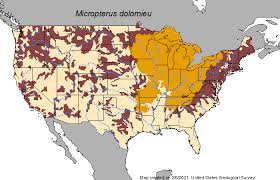Smallmouth bass
Smallmouth Bass (Micropterus dolomieu) is a species of freshwater fish in the sunfish family (Centrarchidae) of order Perciformes. It is a popular game fish, sought after by anglers for its fighting prowess and is native to the eastern and central United States and southern Canada. The smallmouth bass is often found in clearer water than the largemouth bass, with a preference for rocky areas, rivers, and lakes with gravelly to sandy bottoms. It is distinguished by its brown to bronze coloration and the vertical bars along its sides, unlike the horizontal band seen in the largemouth bass.
Description[edit | edit source]
The smallmouth bass typically reaches a length of 12 to 16 inches, but can grow up to 24 inches in ideal conditions. It has a robust, elongated body with a large mouth, where the upper jaw extends to the middle of the eye. The species is easily identified by its brownish to olive green color, with dark vertical bands rather than a horizontal stripe like the largemouth bass. Its belly is usually lighter, ranging from white to yellowish. The smallmouth bass also has a series of dark bars on its sides, which can be more prominent in certain individuals.
Habitat[edit | edit source]
Smallmouth bass are found in a variety of freshwater habitats but prefer clearer, cooler waters than their largemouth cousins. They thrive in streams, rivers, and rocky areas of lakes where there is plenty of cover from rocks, logs, and underwater structures. They are most commonly found in water depths of 1 to 20 feet but can go deeper in search of cooler temperatures during the hot summer months.
Diet[edit | edit source]
The diet of the smallmouth bass primarily consists of insects, crayfish, and smaller fish. They are known for their aggressive feeding behavior, often hunting in packs to corral their prey. The availability of food sources can significantly affect their size and growth rate, with those having access to abundant prey growing larger and more quickly.
Fishing Techniques[edit | edit source]
Anglers prize smallmouth bass for their fighting spirit when hooked. Effective techniques for catching them include using live bait such as minnows or crayfish, as well as artificial lures like crankbaits, spinnerbaits, and plastic worms. Fly fishing for smallmouth bass is also popular, using flies that mimic their natural prey. Fishing is typically most successful in the early morning or late evening when the bass are most active.
Conservation[edit | edit source]
While the smallmouth bass is not currently considered endangered, its habitat is threatened by pollution, habitat destruction, and the introduction of invasive species. Conservation efforts focus on maintaining clean, healthy waterways and promoting catch-and-release fishing practices to ensure the sustainability of the species.
Cultural Impact[edit | edit source]
The smallmouth bass has a significant cultural impact, especially in North America, where it is a symbol of freshwater sport fishing. Numerous tournaments and competitions are held annually, celebrating the skill in catching these challenging fish. The species also contributes to local economies through fishing-related tourism and recreational activities.
This ichthyology related article is a stub. You can help WikiMD by expanding it.
Search WikiMD
Ad.Tired of being Overweight? Try W8MD's physician weight loss program.
Semaglutide (Ozempic / Wegovy and Tirzepatide (Mounjaro / Zepbound) available.
Advertise on WikiMD
|
WikiMD's Wellness Encyclopedia |
| Let Food Be Thy Medicine Medicine Thy Food - Hippocrates |
Translate this page: - East Asian
中文,
日本,
한국어,
South Asian
हिन्दी,
தமிழ்,
తెలుగు,
Urdu,
ಕನ್ನಡ,
Southeast Asian
Indonesian,
Vietnamese,
Thai,
မြန်မာဘာသာ,
বাংলা
European
español,
Deutsch,
français,
Greek,
português do Brasil,
polski,
română,
русский,
Nederlands,
norsk,
svenska,
suomi,
Italian
Middle Eastern & African
عربى,
Turkish,
Persian,
Hebrew,
Afrikaans,
isiZulu,
Kiswahili,
Other
Bulgarian,
Hungarian,
Czech,
Swedish,
മലയാളം,
मराठी,
ਪੰਜਾਬੀ,
ગુજરાતી,
Portuguese,
Ukrainian
Medical Disclaimer: WikiMD is not a substitute for professional medical advice. The information on WikiMD is provided as an information resource only, may be incorrect, outdated or misleading, and is not to be used or relied on for any diagnostic or treatment purposes. Please consult your health care provider before making any healthcare decisions or for guidance about a specific medical condition. WikiMD expressly disclaims responsibility, and shall have no liability, for any damages, loss, injury, or liability whatsoever suffered as a result of your reliance on the information contained in this site. By visiting this site you agree to the foregoing terms and conditions, which may from time to time be changed or supplemented by WikiMD. If you do not agree to the foregoing terms and conditions, you should not enter or use this site. See full disclaimer.
Credits:Most images are courtesy of Wikimedia commons, and templates, categories Wikipedia, licensed under CC BY SA or similar.
Contributors: Prab R. Tumpati, MD






